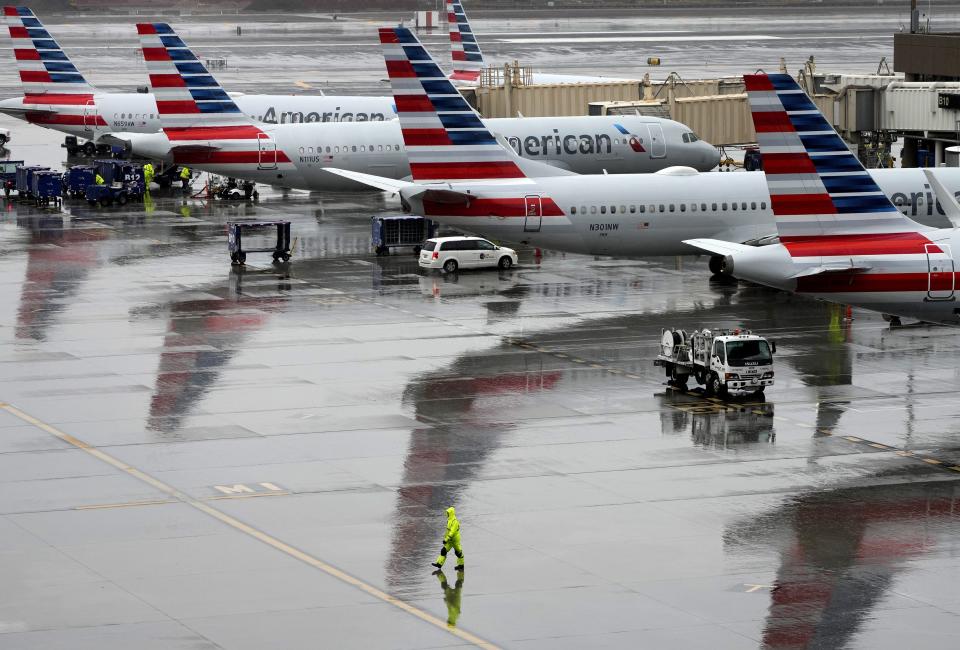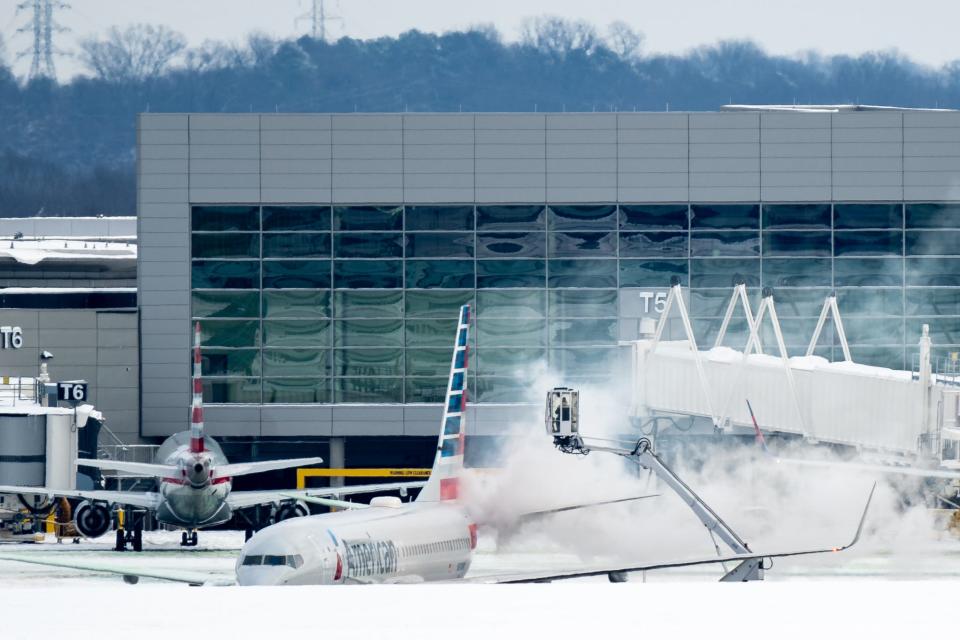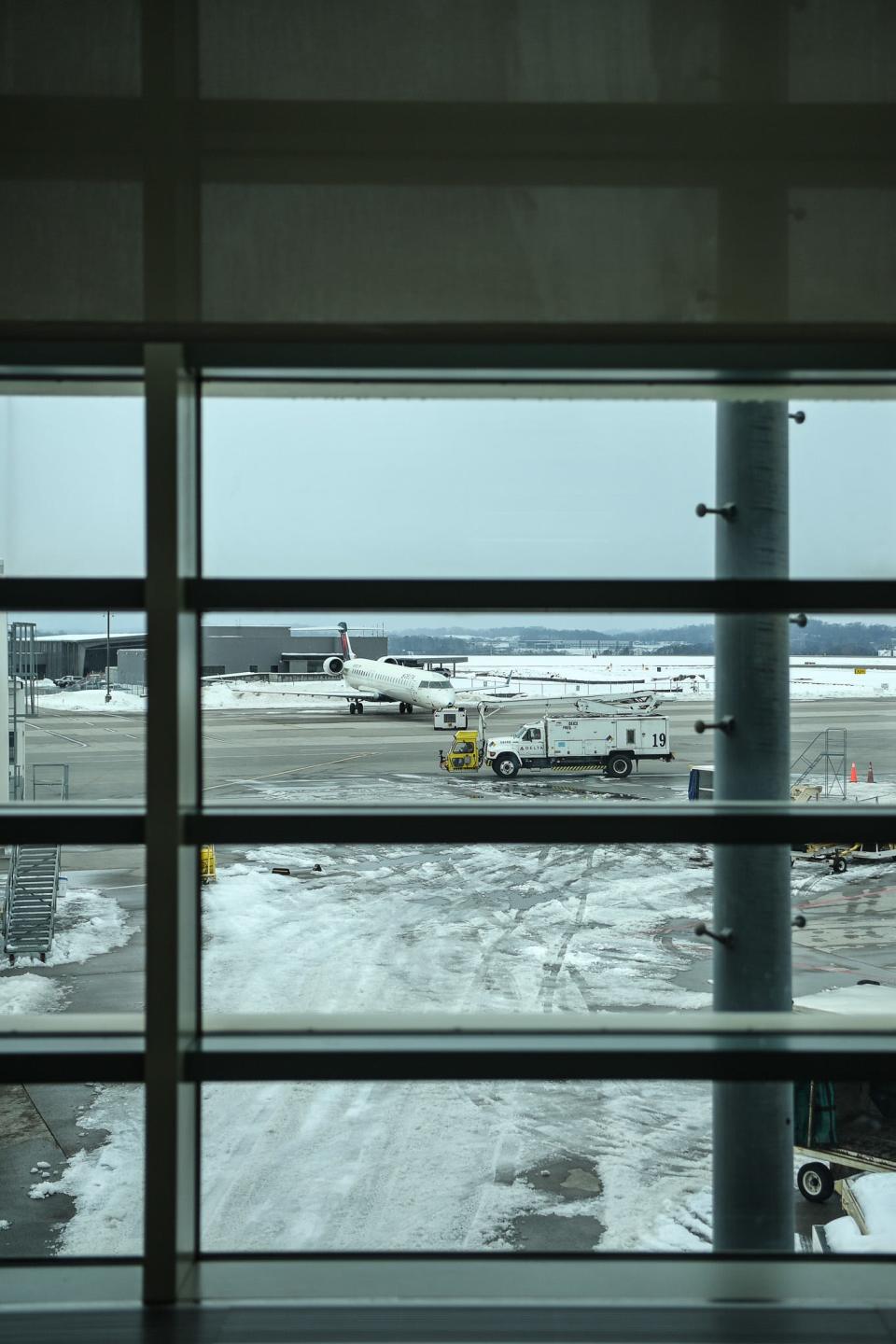Cold weather can delay air travel, but sometimes it's about what happens on the ground
Weather accounts for about 70% of delays in the National Airspace System, according to Federal Aviation Administration statistics, costing passengers and airlines billions of dollars a year.
Upward of 2,000 flights were canceled on a recent Monday after a bitter winter storm hit most of the United States, according to tracking site FlightAware. But aircraft materials are made to withstand extreme temperatures, so why are so many flights delayed and canceled due to winter weather?
Ernie Satterhwait, a multi-engine commercial pilot and flight instructor, said the issue, aside from icing conditions and barometric pressure, is not what occurs in the air, but what happens on the ground.
“Jet engines like cold air, they are most efficient in high altitude, where it's colder,” Satterhwait said. “The higher density of the air gives the plane better lift with less power, meaning better performance in colder weather.”

The biggest problem with aircraft flying in cold air is ice build-up on the wings. Planes are fickle flying creatures, as Satterhwait put it, and too much ice on the wings is enough to bring one down.
As ice builds up, it begins to change the shape of the wings, jeopardizing their structural integrity, increasing the weight of the aircraft, and degrading the amount of lift the plane is able to get. Something as seemingly inconsequential as ice can give false instrument readings and compromise the control of the plane.
Instead of air smoothly flying above and below the wings, it begins to fall in and around the ridges formed by that ice build-up, creating pockets of instability for the plane. Many aircraft have de-icing systems on their wings to help remove ice in the air.
One common prevention method is utilizing small holes in the edge of the wings to distribute an antifreeze liquid to help keep ice from forming. Another popular way of ridding ice from the wing is to keep the wings heated so ice slides off instead of accumulating.
If ice has begun to build, a rubber "boot" can be used by compressing air to inflate and deflate different sections of the rubber to break of the collected ice.

Why the delays and cancelations if planes can operate in cold weather?
Depending on the severity of the weather, ground deicing can cause significant delays. It can take up to 40 minutes to completely de-ice a plane and each one has to wait its turn.
“There's only so many deicing trucks and the trick is, it's a real timing thing. The deicing crews have to get the ice off the airplanes, roll them onto the runway and get them off before it starts to accumulate again,” said Satterhwait. “The deicing fluid is only effective for so long, so especially during a wet snowstorm. If things don’t go according to schedule, planes need to come back through the pit and start the process all over again.”
Ice on the plane is not the only slippery worry; ice on the runway is also a big concern. Earlier this month, an American Airlines plane came in for a landing at Rochester International Airport in New York and skidded off the icy runway, forcing the evacuation of 50 passengers and three crew members. No one was injured.

Ground crew members can shovel snow and scrape ice off runways, and snowplows are used for larger areas, but this can cause potholes or other flaws in the runways that make takeoff and landing more dangerous. In big enough snowstorms, even snowplows would not make a difference.
Visibility is another huge concern for pilots flying in bad winter weather. Snow, freezing rain and fog can produce conditions that officials deem too dangerous to fly.
“Imagine driving in the snow but driving it 100 miles an hour minimum, its that Star Wars effect,” Satterhwait said, describing the snow hurtling by the plane at high speeds like the ships traveling in hyperspace in the movie. “But fog is probably the most dangerous condition. In general, aviation fog is very deceptive, you can fly over, look down, and you can't tell which way is what.”
People are also a source of delays when temperatures drop. Even with the bitter cold and winter storms roaring around the airport, the grounds crew still must work outside to keep the schedule smooth.
People move slower in the cold, bundled up in several layers and joints stiff, meaning efficiency goes down and the time it takes to get everything done goes up.
What to do if your flight gets canceled
The Department of Transportation requires airlines to refund customers if their flights are canceled, regardless of the reason, should the customer choose not to travel. If a flight has been delayed, you may be entitled to compensation.
If the airline made a “significant change and/or significantly delays a flight and the consumer chooses not to travel,” the customer is owed a refund, according to DOT rules. There is no set definition for a "significant delay," so DOT decides whether a refund is due on a case-by-case basis.
If there is a long delay, consider asking the airline staff for hotel and/or meal vouchers. Some airlines will give compensation for delays and cancellations.
According to Delta's Customer Commitment, "Delta representatives are empowered with the flexibility and discretion to issue the following forms of compensation for passenger inconvenience when individual circumstances warrant doing so: cash equivalents (e.g., gift cards), travel credits/vouchers, and/or miles for SkyMiles members."
American Airlines gives meal or meal cash/voucher when a flight delay results in passengers waiting three hours or more and complimentary hotel accommodations for any passenger affected by an overnight delay.
To find out what each airline will or will not give go to the DOT’s Airline Customer Service Dashboard website.
Caralin Nunes writes about weather and related topics for The Arizona Republic and azcentral. Email her with story tips at caralin.nunes@arizonarepublic.com.
You can support environmental journalism in Arizona by subscribing to azcentral today.
This article originally appeared on Arizona Republic: How cold weather slows air travel, affects aircraft

